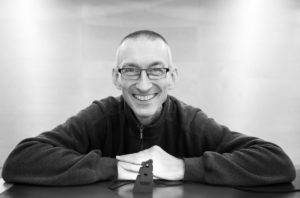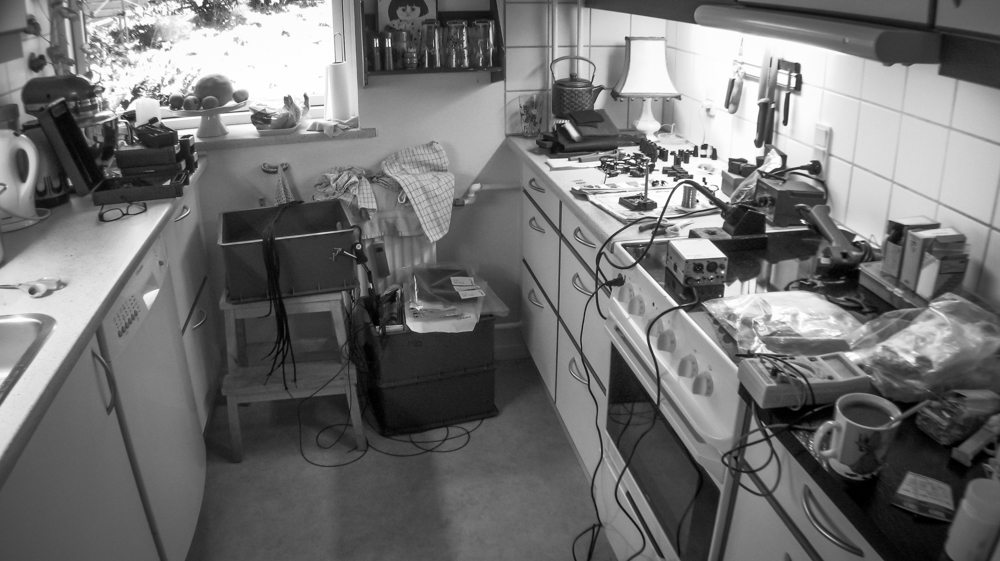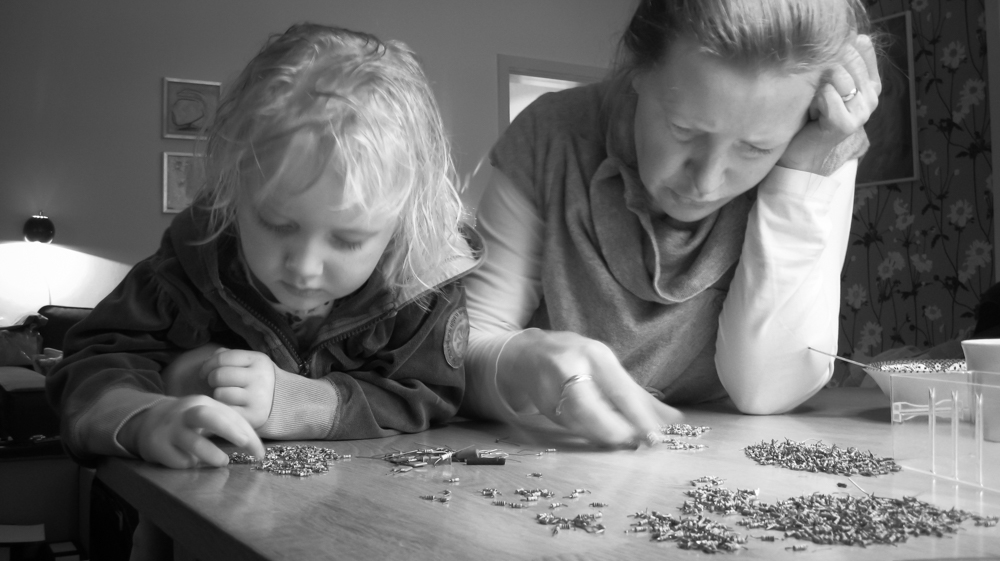
Thorkild Larsen – the human behind REMIC MICROPHONES
This interview was published in the MCGM (Memoirs Classical Guitar Magazine) this month and features a very private portrait of Thorkild Larsen – the inventor, founder and CEO of REMIC MICROPHONES.
“…I never had the perception that failing was something dangerous to avoid…. The ability to learn from mistakes and move on is really what moves you ahead as a human being and as a company.”
Music made me feel accepted
As a child, I always felt like a bit of an outsider, I always felt different than the other children, was never really part of the community. I believe this basic feeling was because my mother wanted a girl and got a boy instead. I was left very much to taking care of myself, I was on my own a lot, so I sort of invented my own way of seeing the world. My life with music started, when I was 4 years old and my grandfather made me a guitar out of a cigar box. When I was around 16 years old, I had bought a Spanish guitar, learned to play the guitar. A defining moment happened for me in those teenage years; I auditioned for a band in a basement – a laundry basement with clothes hanging all over the place to dry. They accepted me and this was really a special moment. Becoming a member of a band gave me a place, where I felt accepted, a place to belong somehow. I played the guitar and I started singing and I suddenly found a way to express my feelings.
The Sound Engineer Years
In 1984, I finished my education as an electronic engineer. During my studies, I had worked in one of the sound rental companies and recording studios in Aarhus, the second largest city of Denmark. Here I got some experience with the industry from many different angles; mixing sound for live performances, repairing microphones and cables, loudspeakers, amplifiers and mixing consoles.
In April 1984, I founded “2R Danish AV Research”, a company primarily aimed for service and repair of high-end professional audio and video equipment, but also developing non-standard solutions for the Danish National Broadcast Organisation and later also “TV2”, another national TV channel in Denmark.
1987-1989: The US Years
In 1987, I had some challenges in my private life and needed a fresh perspective on life, a new beginning. I sold all my belongings and moved to the US for a couple of years. When I returned to Denmark two years later, I tried getting back into the music environment that I had been a part of before. I reached out to the studio environment related to the Danish Musicians Union, then I started a band called “Steve Amman Project”. I continued working as a sound engineer and with service of audio equipment in my own company. At this time, my base became the “Nørgaard Recording Studio” near Silkeborg, my home town.
1995/96: The first REMIC Ancestor
During the years, when I repaired high-end microphones for e.g. the Danish National Broadcast Organisation, I learned about all the flaws of the existing microphone types. None of them really solved the challenges of the musicians: to express the true sound of the instrument and the personal artistic expression that they had been working to obtain their entire life. The microphones always changed the sound of the instruments, there were feedback problems etc. In live settings, feedback and “bleed” from other instruments on stage were always a problem, so you could never place a violinist next to a drummer for example.
So I decided that I wanted to build my own microphone, which did not have the flaws that the existing microphones had.

The family kitchen where the first REMICs were handbuilt
After many experiments, I found a particular material with acoustic properties that lived up to my requirements. I found a place where they could produce this material at a larger scale, then started producing series of microphones, still on a relatively small scale. At this time, we are talking about a “general purpose” microphone that could be used on all kinds of instruments, violin, saxophone, acoustic guitar, drums and percussion etc.
Later I developed a series of more instrument specific microphones; for grand piano, brass and woodwinds, percussion and some especially aimed for the bowed instrument group, which was also divided into two different groups of sonic environments; A live version for extreme live performances and a studio model for studio recordings. This development took place until 2004 when the project ended.
Community Mindset
Since the beginning in 1996, I produced microphones as a project and with a community mindset. The community that helped me with feedback in the development phase consisted of musicians, sound engineers and instrument makers. Around 1997/98, I started developing a microphone version for studio use. The challenge in existing microphones were that they did not capture the nuances of the instruments. I wanted to understand how one could capture these nuances, so I had to learn how the different instruments amplify their own sound. This was the beginning of my collaboration with various instrument makers.
The Centuries-Old Wisdom of the Instrument Makers
The instrument makers taught me a lot about all the details that matter for the sound of the instruments; the choice of strings, types of varnish, height of the bridge, tension of the soundboard (belly) and pressure from the strings etc. when talking bowed instruments. From those conversations, I mapped out all the elements that add nuances to the sound of each particular instrument. I learned how each type of instrument (upright bass, cello, viola and violin) amplifies its own sound. Then I started from scratch again and developed the studio versions of the microphones.
During the period 1995-2004, our microphones ended up in the US with producers from the CBS broadcast corporation. Already then, I had some indication that we were on to something that was different from existing solutions. However, it was all done as a project that was never supposed to continue. But the musicians came back to me asking for upgrades or repair of their microphones after a few years.
They all wanted to know if I were going to make more of those microphones. I had a great friend, a musician with a business mindset, who pointed out to me that there was a business potential for what I had developed, and then I realized that I had created something with a potential for more than just a project.
2009: “You are not part of the Acoustic World”
In 2009, right after the global financial crisis hit us all, I decided to do something about the demand for more of my instrument specific microphones. None of the banks were willing to finance the start up of a company, but since I had been in the world of artists for many years, I knew that there is always a way to create something. So I did not give up.
I went to some of the big industry players to collaborate, but they did not see the potential in my microphones. They simply could not follow the mindset and the way of thinking that I had implemented in my research and development. It was too different from the traditional thinking in microphone development. They explicitly told me that I was not part of the acoustic world.
I found a local business angel, through a fund for regional development in Denmark. This business angel helped me gather a team of professionals with expertise in each of the necessary areas to start a business; production, finances and marketing. One man is unable to do it all on his own and just like in the development of the microphones, I started collaborating with the right people to make this happen.
2012: REMIC is born
Three years later after I had decided to continue with my instrument microphone development in a professional company structure, I finally had the necessary team with many years of experience from the acoustic world. The next challenge was then to gather all the big artist names in Denmark and create cases with them as REMIC users. These cases were used to start selling microphones and to raise capital from a fund that invested in REMIC.
The name REMIC (Re-Mic) is an old English term which means “replace your microphone”, which I found was a great fit for my way of thinking.
The Community Support
I continued running the company like the project I had developed the microphones in. The community mindset is a very important aspect of the REMIC DNA, we continue developing with the support of a group of musicians and sound engineers, who do field tests for us and give us feedback for a very long period of time to make sure that we have all the necessary input to keep up the REMIC quality.
Family Support is my Cornerstone
During many of the years of development, the support of my family has been one of the cornerstones and it continues to be so. Before we had the development facilities, my father- in-law let me borrow his garage in the summer time for my development projects, and in the winter time, when the Scandinavian weather makes it too cold to work out of a garage, I had to work in our kitchen at home. My wife and five children have been involved from the beginning sorting parts for the microphones etc.

The wife Hanne and youngest daughter Vilma sorting parts for the first generation of REMIC MICROPHONES.
Breaking down Barriers between Artists and Audience
REMIC’s point of departure are the instruments and how the artist wants to express their individual style the artistic expression. REMIC microphones give the artists the possibility to capture sound very close to the authentic sound of the instrument, a pure and undisturbed sound. We say that REMIC breaks down the barriers between the artists and the audience. Barriers are usually created when microphones do not express the true sound of the instrument.
Artists spend years finding the right instrument and they spend a great part of their life perfecting their own individual sound with thousands of nuances. They want to tell a story through music, a story that moves the audience, so we see our job as being able to capture this story in an undisturbed way and bring it to the audience the way the artist intended. We believe that this is the way REMIC can become a game changer in the music industry. Using the construction of instruments to develop microphones is a new way of thinking.
Curiosity as the driving Force
I have always been curious by nature and never afraid to fail. My driving force is curiosity, which means that I never stop developing ideas and experiments. When I finish a development project, I am of course pleased about it, but then my curiosity kicks in and I am eager to do something more, something even better. My head simply does not stop developing solutions. I get a new idea and get excited about it and then I have to develop it further. I always believed in the basic perception that if the solution you need is not there, then go out and develop it.
I believed that this optimism was something I developed as a shield, when I was a child and teenager. Being raised the way I was and never really fitting in made me develop optimism as a way of meeting the world around me to confront the resistance I experienced.
Mistakes are what move you ahead
In 99% of the cases, there are mistakes in the development process of a new product before it is released to the market, but I never had the perception that failing was something dangerous to avoid. I just dive right into the ideas that I get, and I strongly believe that it is not until you actually learn from mistakes that you can really change something and move ahead. The ability to learn from mistakes and move on is really what moves you ahead as a human being and as a company.
If you fit in, you don’t stand out
The natural curiosity also helped me develop as a human being. I felt like an outsider, when I was a teenager, but I realized that when you don’t fit in, you stand out and this can actually be an advantage. During my life so far, I actively created the world around me, so I no longer feel like an outsider, but I still stand out somehow and that is reflected in every REMIC product. It is like every REMIC microphone represents some of the curiosity and the feeling of being different that I have always dealt with as a human being. If you fit in, you don’t stand out.
